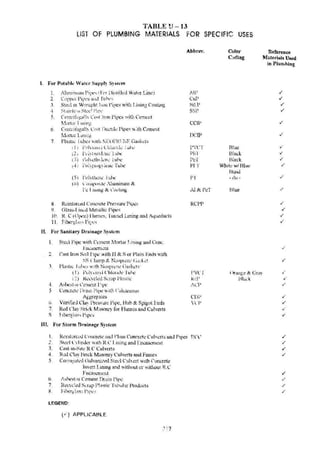The history of plumbing practice in the Philippines dates back to the 17th century when the Spanish established Intramuros as a model community incorporating European plumbing standards. In the 18th-19th centuries, Filipino plumbers maintained plumbing systems in towns and buildings. The practice was formally recognized in 1902 and the first plumbing code was adopted based on the U.S. code. In 1935, the National Master Plumbers Association of the Philippines was established to regulate the industry and assist in passing laws. The Plumbing Law of 1955 established the regulatory framework for plumbing that was later updated in codes in 1959, 1967, and 1999.
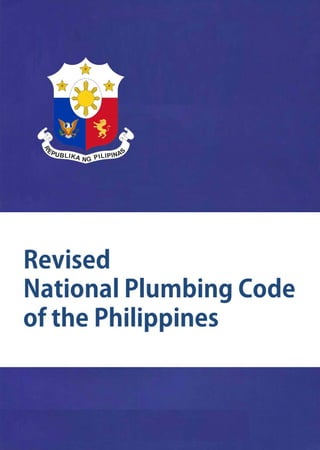

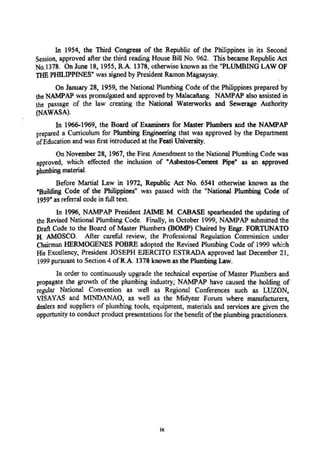
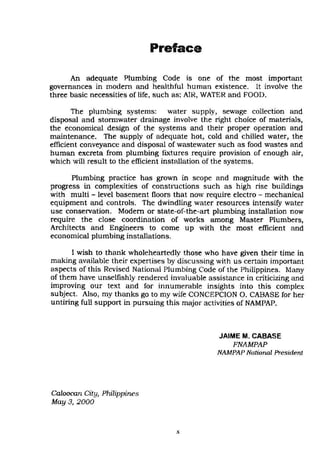







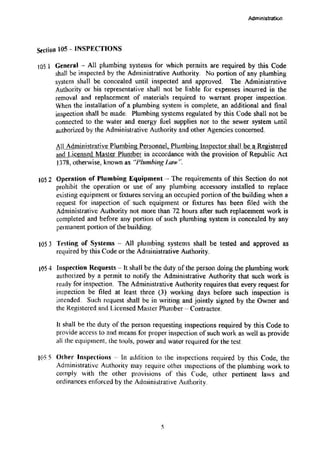


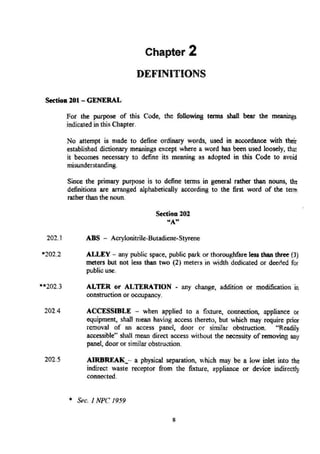




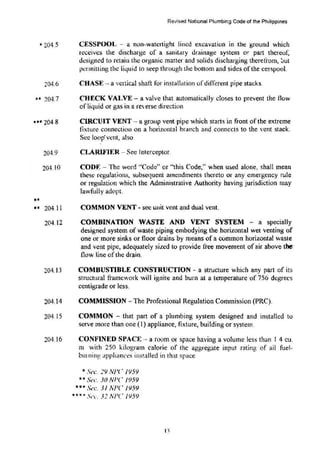

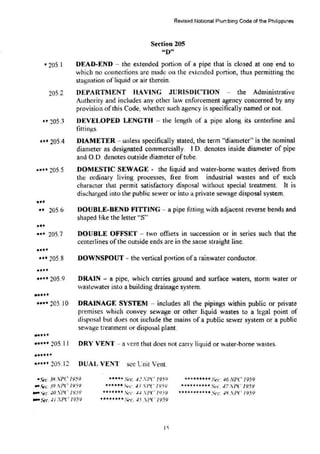
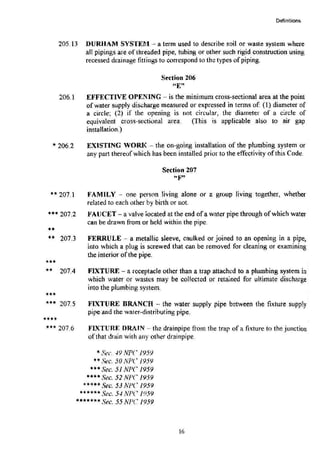










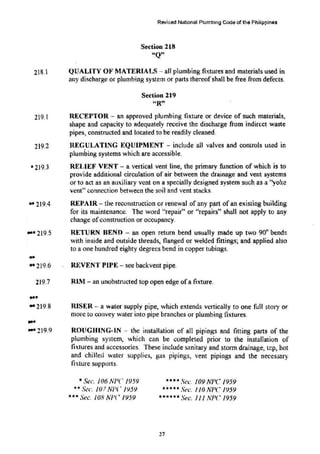



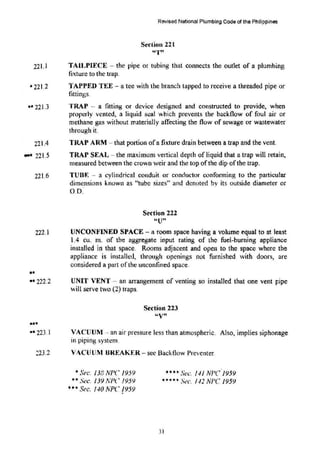
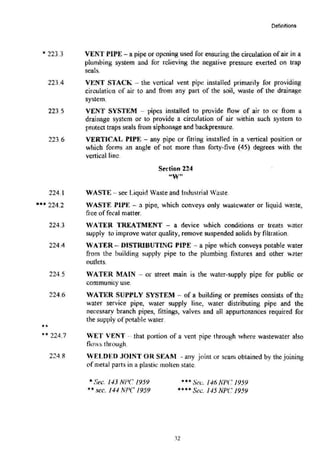



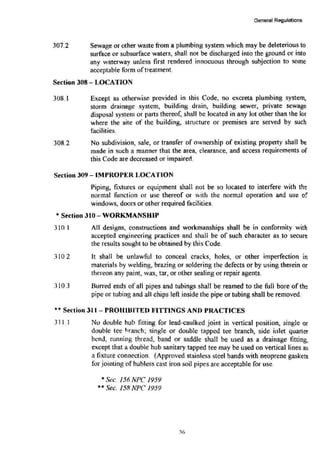
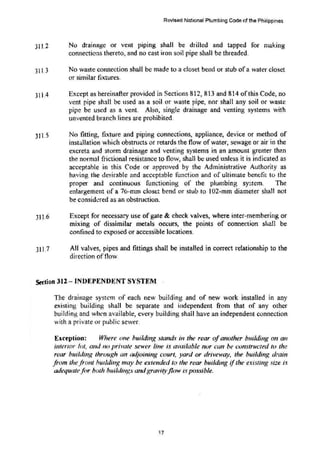











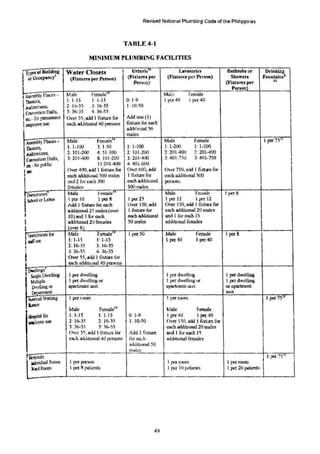
![Plumbing Fi).tures
bd~u;al" Male ''"""'_
1_______Up to 100, I po:r 10 f'Shower for I per 75'!Tj
Weschotiscs I: 1-10 1: 1-10 pen;ons each 15 persons I
Wmkshops. 2: 11-25 2: 11-25 expo$00 to
I
!=-oundries and 3:26-50 3: 26-50 Over 100, l per 15 excessive heat
Otlt<:r 4: 51-75 4: 51-75 persons7
•
8
or to skin
I
e-,"tahlishments (for 5: 76-100 5: 76-100 contamination
~;Jioyee use) Over 100, add 1 fixture for with poisonous,
I
each additioual 30 persons inf<!Ctious, or
l
irritating
I
tMterial
lnstilutional- Male Female 0: 1-IJ Male Fernule I pt'1' 8 l per 7S1
T
1
L'ther than I per 25 l per 20 1: 10-50 I per 10 l per 10
I
Hospitals or Penal Add I llxiure
Institutions(on f<'f euch
I
each oc.:eupicd additional 50
lioor) ltll:tii:S
Institutional- Male Female 0: 1-9 Male Female 1 per 8 I J)(11'STT l
Other than l: 1-15 1: 1-15 1: 10-50 I per 40 1per 40 I
Hospitals or Penal 2: 16-35 3: 16-35 Add I fix1ure i
Institution (on each 3: 36-55 4: 36-55 for cnch i
occupied floor) for Owr 55, add I f:xture for additional SO I
employee use c.a~h aJc!ilionnl 40 pcr:;;)ls male:;
~-~
j Otlicc or Public M<
lc h :nwlc 1: 1-HJO Male Female
I "" 75 I
1
Du.ldir.gs J· 1-tOO I: 1-200 2. 101-200 1: l -200 1: 1-200
I 2 101-200 2: 201-40() ) . 20I.....!()() 2:201-400 2: 201-400
3: 2()1-400 :1-401-750 4•401-600 3• 401-750 3: 401-750
Ovc.:r. 55, add I lixture for Over oUO, add Over 750, add l f;xtuJ<: f01 ;
~..ech additional 500 males I fixture for each additional ~00
I
and 2 l(lr ce.:h 55 fem&cs e.~ch oJditional ~JSOllS. l
~_l() ma.~- _j
Office or Public Mlle Femalerr-· 0: 1·9 !A.ale tc:nmle
I
Buildings- for I: 1-15 I: 1-15 I: 10-50 I per 40 1 per 40 i
employee use 2: 16-]5 3: 16-35 A<hl 1 fixture I
3: 3(·-55 4: 36-55 for each
'
!
Q,·cr 55, add I fixture for addtt.ionnl SO
I
each additional 40_ll(:l'~ns males
I I I
P~·nal Institutions - Male r c:malc'r 0: 1-? M<Jc i'l'IIOJc
I
lpcr~
For employee use I: 1- I5 I: l-15 1: 10-50 l Jl<!r 411 l P.,'T 40 i
2: 16-3' 3: 16-3S Add I tixture
I
i
3: -
' 6-55 4: 36-55 for c.
'11~.:h
~-,p>~
Ovcr 55, add l iixturc lor P.dilitional 50
each additi~J.!!_~~-40~son;>_ ~~lcs
Penal lnsliruuon -
ror Prison usc bloc.k floor i
I Cell 1 per cell I pc:r cell !per '
Exercise Room l pere>;er<.:isc room I per exercise I per exercise room exerl'ise !
room room
Restaurants, Pubs Male Femlllc l: 1· 150 Male Female" ....
and Low1ges11
1: l-50 1: l-15 Over 150, add I: 1-150 I. l-150
2: 51-150 3: !6-35 1 fixture for 2. 151-200 2: 151-200
3: 150-300 4: 3ti-5~ each !Jdditionnl 3: 201- 1(1() 3: 201-400 !
Over 300, add l !ixttu-e for ISO males Over 400, ntl<l 1 fixti..U'c lor
each &ldi1ionnl 2~JO Cll~o:h nddilwuui 400 '
w._-..:r.<~·~~~---·-·--.. '
)!!I '
Schools- for sta!T M-~---
Fctnal~-- f-·-- ----
I 1x:J 50 Mt~k Fcrnule ~
use I: 1-1 S I: 1-1 S I Jl<!l'·lli I pcr4!J
I
I
All schools 2: 16·35 3 16-35 I
3: 36-55 4: 36-55
;
.
Over SS,ud llixturc f1>r
I
;
e-a~h aJdilionai ~0 persons I I !
. -........!
50](https://image.slidesharecdn.com/188541488-revised-national-plumbing-code-of-the-philippines-220526020013-b02da330/85/188541488-Revised-National-Plumbing-Code-of-the-Philippines-pdf-57-320.jpg)












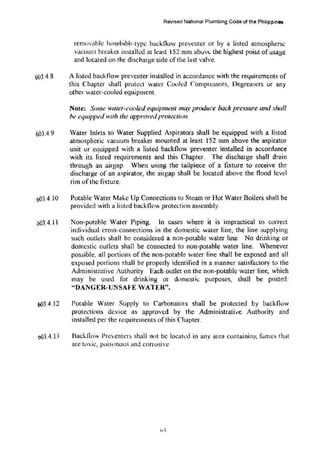









![Revised National Plumbing Code of the PhilipptMs
Stction 610- W.<TER CONSEUVATION
610.1 The maximum discharge flow rates for plumbing fixture fittings shall be in
accordance with applicable standards listed in Chapter 14.
610.2 Flush volumes for luw consumption and water saver water closets and
urinals shall he in accordance "lith applicable standards listed in Chapter 14.
TABLE 6-5
EQUIVAI.ENT WATER SUPPLY F'IXTURE UNITS
(h1cludes Combined Hot and Cold Water Demands)
----~r--·-------------------------------,---------~----------~
- ~mber of Wat.er Supply
i
: ltero No. FIXTlJRE h rure Units (WSI<'t,;)
t I -~!!!_~~~~k -- "·-·-·----- ---- ·- - ··- ._ ..,___..____ _J__ --~:~-L-~~~~]
- 2_ _ _E!~t~~~~ l~~.~.~~ ~~ _
yvttho_~.~~~o:'-~!.Qr~!L__ ___ __.L......-- -2
__ . ___.t..,._ _ . L ...____..
1
.
~ _!?.~J~-~---·-"-· ·-"'·-------·--·--·------·-----t-------·~---·---.l-·--··4
_ ____
~---~~~~~~f~1~!~~~Ct)--------------- :-----T---+-+---
---·.
I 6___
t.!:l.2~B-~~~..2!'.~~~~£~~.~~!!1..!'!-~d_!l~l_ _ ,_- ----._
..f____ }
___.-'-...---~--..__
___-~
;7 -r~?u'~-T.~b.-~~~.!:b-£~-~y~~.!..C.~J.cacE~-~r.~.l;l£~~s.L..t....-...~____ _
1._ ........-~-----j
::+-~~~~~~~~~
~-=r---+------f:=:~=t-:-~~
:"" II_ _ ~~)~]-~~~~.!::.i~E!!l___ _ __
_ .·----- -....- - ....- L._.__j!,_______j---·---(~-------1
:----)2 Sho~icr (ca_s_!!_~cad)_
__
____
_ _
___ _ _
_ _
_,._ ____l - ·--~- .___
_± __ _ ~
:- n _ _S.!~-{~.!!2. ____
_ ____ .._
.._______....- - - ·- ·-·-·J ...__ _ _
J ____ _J.___ ......~....-- -~
~ Sin~_ifi_!Jsh~~-Ji~~~~~ill.___ ..___ _·------------·1··--·__
-___..~____
_j_
9,___-·_ j
;- 1s Sink or dis~.!'ashe.r . 2 l 4 j
r 16 Sink(w~tsh..:-~.I£Ei~cular~P.i~} ., -. -·--··t-----~---..-l
r 17 Sink ~~:•..t,sh-up•.~~-~ct of!aucc~L_ _ ___ ,_--r - ·-· .,_ __!._______!
I 18 Urin~J..fl!.:~.t~~lk) _ ____L__ _ _:__ __J_
,.,_ _ l__ _ __~
; !9 Urinal (P.¢..£1~~~~~-g~;
~intiJ.£1f...!l.P.£)
_ _ _ _ _____ .._ ___::______ __
_ L---~---..
1
'
W
}---~1~;~;~)l--n.~h·~·-··--------·-·------- - -- -~-----L ---'i-----
_J. __ __ --- - ---~- -· ---~- - --- - -·- --- -- -------·~··-1. -
--- ..........___
:tt-~~:~tfl::t~it~:;~~~:~,~~~I~~==--=-:::-_:__:=~=~-=~~=-:=: !:==- ::-~ -~- 1
1
Water suppl.
r omkts for items not listed above shaH be 1
Icomputed at th~ir n~aximum demand but in cas~ less ~
F
th:l.P~ ---------------------- ---- ---------· - -----
------r·-------
··
-
-
-.J
- _ _ ! ...:.J...~~'!!... -- - ------- ~··-··-·-J- ..--- -~---·-~ ..--·.....!
h - l.lmm 2 4 :
r--- ------------
-- ------- - - - --- - ---
--- ...1
r---......·~--->~~:i::;,...---- ·--
----_
_
...----
--
·-·1 -------k........... · - ___
.. ri)- ... .
______.______ - --~
• See Subscl·uon M1Y.Y of Se~..·tum ()09 for method f?( sizing .flushometer valve
installilfions usmg /'able 6-6](https://image.slidesharecdn.com/188541488-revised-national-plumbing-code-of-the-philippines-220526020013-b02da330/85/188541488-Revised-National-Plumbing-Code-of-the-Philippines-pdf-80-320.jpg)

![..
.,.,
...
..._..,..
...
"'""'"•
c..-._.
'"-
"""'~~tt"'"
TABLE
6-6.2
PRESSCRE
Ri:GE
-
~
17
to
_..I
>
KPa
146
to
60
psi)
Meter
Bw
!dmg
and
supply
Item
street
3.!'d
Ma-ximum
Allowable
Length
in
Feet
(meters)
"0
SC!"'JCC
br::r::~hcs
(
mml
'rnrn~
{
_
12>
(lK)
(24
)
(30)
(~)
(61)
(76
)
J9!)
(!22)
(152)
(
183
J
(2
13)
(24-+)
n7~i
(3051
I
19
J
~
~
7
()
5
~
~·
.,.
2*
I*
,.
I*
o•!
o•
o•
o•
I
2
j
l)
~
()
20
20
19
17
14
•
ll*
9*
g•
6*
5*
...
4•
3*
~.
.)
3•
J
<)
"'
.::
39
~9
·'
36
11
28
.,,4-~
:
i
l
19
17
14
12
10
9
8
~
~
.t
25
}~
3lJ
39
39
16
30
25
23
20
18
l5
12
lO
9
8
&
5
2S
·,
j
n
78
76
67
52
H
:'l9
36
30
.,.,
,_,
N
20
19
17
16
6
3X
~
,
7~
78
78
78
6(.-
52
-l-4
19
33
29
2~
20
J<J
17
i6
7
::lS
_
;:-;
151
151
lS
1
151
123
lOS
'-}0
78
t.2
52
~2
3~
35
32
30
~
5!
'"
I
51
151
!51
15
!
150
117
98
84
67
.
.
.
~
:'I
-1:'
38
:>5
3~
}IJ
')
.1
8
'
J
370
)70
340
318
272
l·W
220
19S
170
150
ll'>
!2'
1
:tl
102
94
]()
51
~!
370
3iti
370
370
368
3
!8
2
~0
250
205
]
{;5
142
12:
[jl)
W2
9
~
ll
51
04
654
[
(,~0
610
I
580
535
500
!
.
-+70
'
~40
400
.
1f>1..
L.._3,_
5_
L.._
}
l5
2S5
'267
2)
0-
-
-
-
I
psi
=
6.895
Kpa
75](https://image.slidesharecdn.com/188541488-revised-national-plumbing-code-of-the-philippines-220526020013-b02da330/85/188541488-Revised-National-Plumbing-Code-of-the-Philippines-pdf-82-320.jpg)




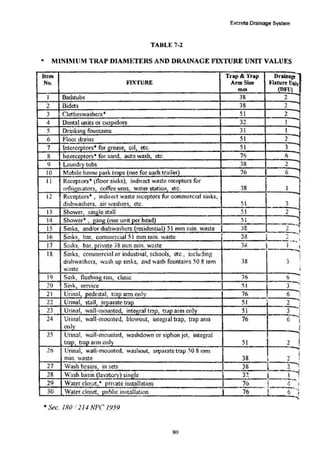


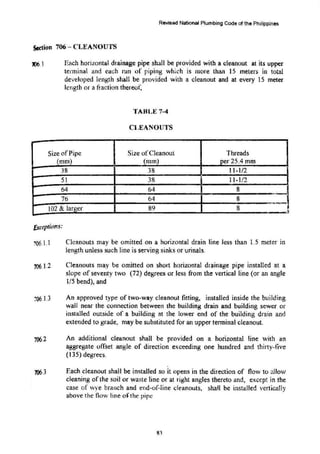








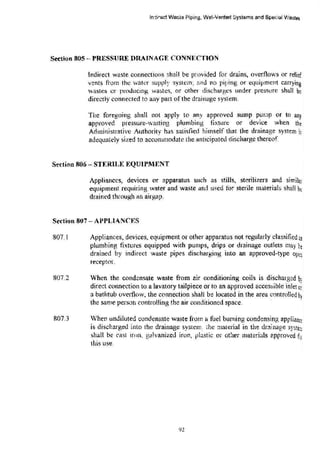
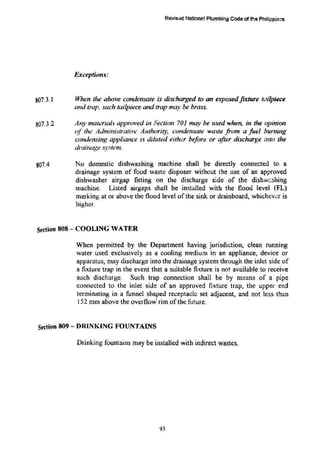





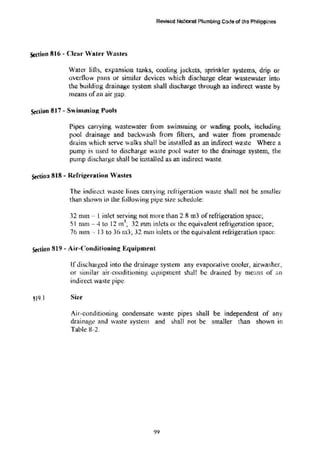







![Revised National Plumbing Codtt ~ f.'te Phi:ippines
1002.2 Each fixture trap shall have a protecting vent so located that the developed
length of the trap ann from the trap weir to the inner edge of the vent shall
be within the distance given in Table 10~ l, but in no case less than two
times the diameter ofthe trap arm.
1002.3 A trap arm may change direction without the use of a cleanout when such
change ofdirection does not exceed ninety (90) degrees.
Exception: For trap arms 76 mm in diameter and larger, the change of
direction 1101 excel!ding 22 %0
110 cleanout is required andfor change of
direction greater tlum 22% 0
a c/eanout is required at the bend
1002.4 The vent pipe opening from a soil or waste pipe, except for water closets
and similar tixtures, shall not be below the weir ofthe trap.
TABLE 10~1
Horizontal Distance of Trap ArmG
(Except for water closets and alm.Jlar fbrtmez)
Trap Arm
Diameter Distance To Vent
Mm m
32 0.76
38 1.07
51 1.52
76 1.83
102 & larger 3.05
Slope 2% or 20 mrnlmeter
* ]he developed length betwee11 the trap of a water closet or similar fixture
measuredfrom the 1up ofcloset ring (closet flange) to inner edge of~·ent sha!l not
exceed 1.8 meters.
107](https://image.slidesharecdn.com/188541488-revised-national-plumbing-code-of-the-philippines-220526020013-b02da330/85/188541488-Revised-National-Plumbing-Code-of-the-Philippines-pdf-114-320.jpg)

![Revised Nstional Plumbing Code of the Philippine:>
"Section 1006- FLOOR DRAIN TRAPS
Floor drain shall connect into a trap so constn.:~ted that it can be readily
cleaned and of a size to serve efliciently th-~ pu! po$~ fu: which it is
intended. The drain inlet shall be so located thd it is nT! times in full view.
When subject to reverse flow of sewage or liquid waste, such drains shall
be equipped with an approved backwater valve.
Stttion 1007- TRAP SF.AL PROTECTION
Floor drain or similar traps directly connected to the drainage system and
subject to infrequent usc shall be provided with an approved automatic
means of maintaining their water scats, except where not deemed
necessary for safety or sanitation purposes by th-~ Administrative
Authority. When automatic trap priming devices are installed, they sh1ll
be accessible for maintenance and provided by an accessible shut··off
valve.
Stction 1008- INDllSTRIAL INTI!:RCEPTORS (CLARIFIERS)
AND SEPARATORS
10081
1008 2
t008J
10084
]008.5
Vht-n Rt•quired- ir:tcrceptOis or clarifiers (including f.'.l"(:asc, oil and sand
interceptors, etc ) shall be provided when, in the judgmf.'nt of the
Administrative Authority, Hwy are necessary for the proper handling of
liquid wastes containing grease, f.:-mmable wastes, sand, solids, acid or
alkaline substances, or other ingredKnts harmful to the building drainage
system, the public or private sewer and sewage disposal system.
Approval·- the size, type, and location of each interceptor (ch:tir·:r) or
separalor shall be apprcved by the Administrative Aulho.1ity, in
accordance with it~~ ~iaudanh; Except where othcrwi~w :ipe<:ifically
permitted, no wastes other than tho$C requiring trcatmc-al or scpantion
shall he discharged into any intt'rceptor or clarifier.
Design - interceptors or darifkrs f(:n sand and similar heavy solids s:l:,;r
be so designed and located as to be readily accessible for cle?.ning r:i~
shall have a water seal ofnot less than l52 mm deep.
Rdi~f Vent - inte;-ceptors or clarifiers shall be so designed that they wir
not become air beund if closed covers are u!>,:d. . Each intercept ,r
(clarifier) shall be properly vented.
Location - each interceptor or clarifier shall be readily accessible for
servicing and maintaining in working and operating conditions. The use
of ladders or the removal of hulky equipment in order to service
interceptors or clarifiers shall con!,titute a violation of acccs~ibility.
Location ofall interceptors (darifiers) shall be shown on the bu;tdir.g plan
submitted t<.)r approval by the Administrative Authority.
• S1'C. I Y1 N}'(' IY5Y
109](https://image.slidesharecdn.com/188541488-revised-national-plumbing-code-of-the-philippines-220526020013-b02da330/85/188541488-Revised-National-Plumbing-Code-of-the-Philippines-pdf-116-320.jpg)


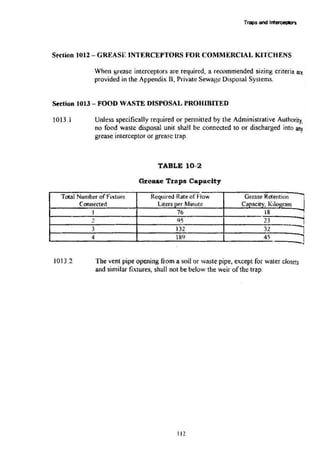
![Revised National Plumbing Code of the Philippines
TABLE 10-3
Horizontal Distance ofTrap Arms
(Except for water clost!ts and similar fixtures)*
Item Trap Arm
Distanc,e
Trap to Vent
No. mm
mm
1 J6 762
2 38 1067
3 51 IS2:1.
4. 76 1829
5. 102 & larger 3048
Slope one-tourth (1/4) inch ,eer foot ~20.9 mm/ml, s = .02
• The developed length between the trap of a water closet or similar fixture
(measured from the top of the closet ring [closet flange] to the inner edge of the
vent) and its vent shall not t!xceed six (6) feet (1829 mrn).
Stction 1014 ·Traps - Described
1014.1 Each trap, except one for an interceptor or similar device shall be self-
cleaning. Traps for bathtubs, showl
~rs, lavatories, sinks, laundry tubs,
floor drains. hoppers. urinals, drinking fountains, dental units, and similar
fixtures shall be of standard design and weight and shall be of ABS, cast
brass, cast iron, lead, PVC, or other approved material. An exposed a.nd
readily accessible drawn brass tubing trap, not less than 17 B&S Gauge
l. I mm, may be used on fixtures discharging domestic sewage but shall
exclude urinals. Each trap shall have the manufacturer's name stamped
legibly in the metal oflhc trap and each tubing trap shall have the gauge of
the tubing in addition to the manufacturer's name, Every trap shall have a
smnoth and uniform interior wat~rway.
1014.2 No more than one (1) approved slip joint fitting may be used on the outlet
side of a trap, and no tubing trap &hall be installed without a listed tubing
trap adapter.
li3](https://image.slidesharecdn.com/188541488-revised-national-plumbing-code-of-the-philippines-220526020013-b02da330/85/188541488-Revised-National-Plumbing-Code-of-the-Philippines-pdf-120-320.jpg)









![Storm Drainoge System
Continuation of TABLE ll-2
.-----·------ ---·- ·----- ----- ··..·- - ··- --- -- - -- ·-- -- ---,
TABLE lt-2(
1----- - - ·- - -·--·- - - - - - --- -
- - - -------- -----1
IIORIWNTAL PROJECTED ROOF AREA IN SQ. M.
1------..--·---+-- ·-···-- ·-::--:-·--:----._,......---,-------::-- - - -- - --t
Maximum Rainfall in mm/br.
Size of
Pipe
in mm
w/ Slopt
41.7
r----- ----~--- ---·--.------r--- ---
51 76 102 127 152
ITEM mm/m I
I _!!_<;>
c..
·~_..JS
_'_
=
_~~-- '--------+- - -·-- I
..---- - r- (2) (3) (4) 15!.__ l
~---f--·--t--J!L_. - - t-----:-~ -
17 76..2 305.5 . _ _ll_l]_ _ _
__
l!.~J ~21]
_ r---.!Q!.:~-~
i 18 101.6 698.6 465.4 349.3 279.6 232.3 I
19 127 1241.1 826.8 .-620:6-- - 494.2 ~"3:4 ~
1 20 152.4 1988.1 1272.3 994 797.1 633.3
I 21 -- ~1:? ~.?74:!__
_~- 28~tLt-- 213~.-7- -1709~~- ~2~2----1
t-z2··· 254 7692.1 5128.1 3846.1 3079.6 2564 _
I
t=*-~~F ~~Jill~} F-~~~="=ms-t---.--~~- --~~-~i.~ I
123](https://image.slidesharecdn.com/188541488-revised-national-plumbing-code-of-the-philippines-220526020013-b02da330/85/188541488-Revised-National-Plumbing-Code-of-the-Philippines-pdf-130-320.jpg)

![Storm Drainage Sye.tcm
Continuation of TABLE ll-3
--- ---------------- ---
- - ---- ---
r l
l
TABLE 1t-3c
---·--.----··-·· ~--·-·-- -·
·-·--- ----·- · ------·-·
Diamder of liORIZONTAL PROJECTED ROOF AREA IN SQ. M.
Gutter 11
-l
w/ Slope ...---····-- ---· ··--·------·----- -·- ·--·
Maximum Rainfall in Mmimcten per Hour
rrEM 20.9 mmlm
-- --- 76--,- -
I ~0. (S = .02) 51 101 127 152
15
________~______i!.L_ ~1_-+____m____ --~L--b---ft.. _
76 63.2 41.2 31.6 25.3 21
---·--- ---· ··---
16 102 133.8 89.2 66.9 53.5 44.6
. -------------- -----
1 11 127 __ _
_ 232.3 ___ 15~·-·---- _
__!!_~_.L, _____ _J2 .~ 77.5
; 9 I I~~----+--}_!.~~--r-_l!L~--'-_1~6..:.4_.._ .. 204.Q __,__
170.9____
~----_
_j_g__ ·-· ···- _357_§__ __ 237_8___ ~__1__?~~-~-___!_42 1-r-.J!!'L__
~ 20 1 203 --t--_7~~-~------!---~~3·~- ---~9.]_ _ 295.1___ f-_2_'!~--
~ 21 1 2_
54--·--· -~l:§ ___ -~L~-- - _._~s-~ 534.2_ 445.9
~
TABLE 11-Jd ij
n~ia~eter~;-r-~~~:,;~N;=~--~~~~~C,;-~~-ROOF:~EAl~SQ.M-~·l'
Gutter *
w/ Slope · ·- - ----------- -- · ----- · ·---···· -----·---- ···-·------ ·- ·---· ·----- _,_,__ - · l
Maxirnum Rainfall in Millimeters per llour
O"EM 41.7 mm/m ...- -- -----. ---·- -----· .... _. .. ...--..·---..- _____.._
___ - ··- -· _______
NO. (S ::: J)4) 51 /6 102 127 151
=----~---..-· ·-·----JIJ_____r-----(2.)__ _____
(~-- (41__ (S)
: 22 _ f---1~--- ______sq·.~----- --~=~--r-- --~:~-6 35.7 . '--297_..J
tJ3-t--J.02 --- · r---· _1.~2--~---· ___126.~---- 94.8 75.8 63.~·-J
i 24 127 -- r-- 328.9
_________?:_~~.:~--- ----~j~____l3l.5 1~9 .6_
i25 1s2 514.7 343.3 257.3 206.2 t71.9 1
"--"--r-----:· __,______ -----·- - - ----· ..
: 26____ E!___ ·----~?:~--~--- -~}..:L_ 362.3 --b-~9.9_~-~~----'
-n 203 1040.5 693 520.2 416.1 346.5
~ ~---12!.__
__ ~_185'8 1238.4 92~_.__ 743_1__l__~1 8.7 __ _J
• Gutter has Semi-Circular bottom. Depth of equivalent area of rectaJI;_.;,ular
ptler = 0.392 x diameter.
~25](https://image.slidesharecdn.com/188541488-revised-national-plumbing-code-of-the-philippines-220526020013-b02da330/85/188541488-Revised-National-Plumbing-Code-of-the-Philippines-pdf-132-320.jpg)

![Storm Drainage System
TABLE ll-5
Size ofGutters
- -·- ···- ·------ - -- -....-------
!
' Diameter • of Maximum Rain
'
I
Item Gutter in mm ---
---
--·r-
--
-·----
.
i No. 5.2 mm/m Slope 50.8 76.2
•
. (s =~·/o_L_ _
i - -
~~~-~Minimeters per Hour __J
101.6 127.0 152.4
1. 76.2 31.6 2 l.O
2 101.() Q
Q,9 44..§..___
3 127.0 116 l 77~5 +--.:;;..;,~-t---..:..=...___--+-=3li__,
4. 152.4 178.4 I 19.1
··--·- .--- --·--·-r·--.... --····--·-
~
5. 177.8 25.<
'L4 I 170 q
~:_E ~~!~ ~~~-
369.7 246 7
' 668 9 445.9
I .__ ___ - -
-
4- ·89?:._
_j___71.4_ _ 58_0
5
·_:
_5
3 1'
128.2 : 102.2
+--...:...
18.:...4
..;..;
.9
_--1i_.:...l4_7_
7_t--1~
2;.;;_;]._
1 - 1
___,_ 3_
34.4 267.6
_ _,__2_2! ~-_j
~-~o·i~:et-
er~-
f - Maximum Rainfall in Millimeters per Hour l
Jte~ I10~uttcr in mm t--- - - .-- -- ----.--
- - - .--- -- - ·- ----;'
; No. l0.4 ~:~~/o~lope 50.8 76.2 101.6 127.0 152.4
• Width ofRectangular Gutter = 0.8862 x Diameter
127
--t----
84
_.1
__
_ ~
120 8 !
173.7 I
-~--3.;;...;l
"""'~D](https://image.slidesharecdn.com/188541488-revised-national-plumbing-code-of-the-philippines-220526020013-b02da330/85/188541488-Revised-National-Plumbing-Code-of-the-Philippines-pdf-134-320.jpg)


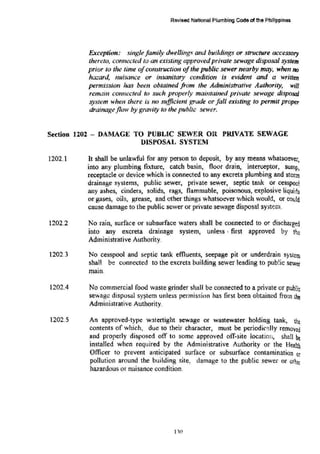








![1302.12
1302 13
1302 14
1302.15
1302.16
1302.17
1302.18
Joints and Connection$
Mt~chaniral Joints - Mechanical joints for centrifugally cast iron water
pipe shall conform to nationally recognized standards.
Molded Rubber CoupHng Joints ··· when pipe is joined by means of
molded neoprene rubber coupling .ioints, such joints shall conform to
approved standards and shall not be considered as slip joints. When
required, appropriaie neoprene rubber bushings shall be used to allow for
any difference in piping material diameters. Neoprene rubber shall be
used in soils subject to oil intrussion.
Elastomeric Gasketed and Rubber-ring Joints- shall comply with the
appli~..:ablc LI,MO Installation Standard. Neoprene gaskets are
recommended tor oil handling piping works.
Bra·lin~ nnd Wdding shall conform to applicable standards in the
Appendix.
Pressure-Lock Type Connection - A mechanical connection which
depends on an internal retention device tn prevent pipe or tubing
separation. Connection is made by inserting the pipe or tubiug inside the
fitting to a prescribed depth.
Shielded Coupling Joints ···When piping systems are joined by means of
shielded couplings, surh couplings shall conform to approved standards
and shall not be considered as slip joints
Hublcss Cast ]ron Pipe Joints -Joints for hubless cast iron soil pipe and
fittings shall conform to appropriate IAPMO Install<!tion Standards and
shall not be consider{'d as slip joints.
Section 1303- USE OF JOINTS
1303.1
"1303.2
1303.3
Clay Sewer Pipe - Joints in vitrified clay pipe or between such pipe and
metal pipe shall be joined with neoprene gasket for hub and spigot joints.
Cast Iron Pipe - Joints in cast iron pipe shall be made as provided in
Subsection U02.10 or 1302.12.
Scre-wrd Pipe to Cast Iron Pi1)e - Joints between wrought iron, steel,
brass or copper pipe with cast iron pipe shall be either caulked or threaded
joints made as provided in Subsection 1302 1 & 1302.2 or shall be made
with approved adapter fittings.
• Sec. 171 NPC 1959
IW](https://image.slidesharecdn.com/188541488-revised-national-plumbing-code-of-the-philippines-220526020013-b02da330/85/188541488-Revised-National-Plumbing-Code-of-the-Philippines-pdf-146-320.jpg)
![• 1303.4
1]03.5
130.3.6
ReviMd National Piumbing Code of the Philipplnas
Lead to Cast Iron, Wrought Iron cr SteeS - Joints between lead and
cast iron, wrought or steel pipe shall be made by means ofwiped joints to
a caulking fermle, soldering nipple or b!!shing.
Copper Water Tube - Joints in copper tubing shall be made by the
appropriate use of approved brass fittings properly soldered or brazed
together, or by means of approved brass compression type fittings as
provid~d in Subsection 1302.5. Solder shall conform to the requirements
ofSubsection 1303.4.
Plastic Fittings ·- Use ofjob-fabricated Female screws of PVC for water
piping are prohibited. fartory made screw and of PVC adaptor fittings
are accept.abie for u:?c ifthi(kness conform to Schedule 80.
Section 1304- SPECIAL .IOINTS
1304.1
.• 1304.2
1304.3
l304.4
1304.5
Copper Tubing to Screw Pipe Joints ···· Joints with thin-walled copper
tubing to thick-walled threaded pipe :.;haH he made by the use of brass
adaptor fittings. The joints between the copper tubing and the fittings
shnll be properly sweated or soldered or made with tlared and screw ends
adaptor fittings the connection between the threaded pipe and the fitting
made with a standard pipe size screw joint Solder shall conform to the
requirements of Subsection 502.4
Slip Joints -· siip joints of approved materials may be used in fixtme
drains and traps. In lixture supply pipings, slip joints are exposed for
faculty in maintenanec
Ex1>ansion .!oints -- Expansion joints shall be accessible, except for vent
and stacks, and is used in soil and waste stacks to provide tor necessary
expansion and txmtraction joints ofthe pipes for high-rise buildings. In all
cases such jl)ints shall be tree and accessible
Unions-· Approved unions may he used in drainage work when accessibly
locatf;d in the traJ> s~a! or between a tixturc and its trap; in th;: vent system
except underground or in wet vents, at a<:l~essihle pc,ints ir~ the water
supply piping system and in gas piping .
Ground Joint, Flared or Ferrule Connections - Brass or copper
ground joint, tlarcd or ferrule type conuections when made up, shalt not
be considered as slip joints.
*St.?r. /7-1 NPC 1959
**Sec. !7fi NPC 1959
140](https://image.slidesharecdn.com/188541488-revised-national-plumbing-code-of-the-philippines-220526020013-b02da330/85/188541488-Revised-National-Plumbing-Code-of-the-Philippines-pdf-147-320.jpg)



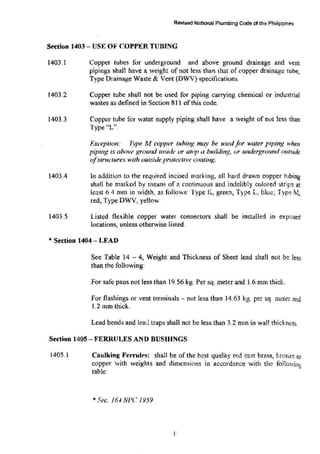





![ReviSed
f~tional
Plur!•bing
Code
of
tl'le
Philippines
i·~:;-l
·
-
-··
~~~M
---
·
-
-------T
~~)S-~A~~·
F~~M-r;,~
~-,':.ia-1
~;~tt
~
s
j·c~~
T
RE~R~~-~
i
-
-
-
--
-
-
-
-
-
····
..
··
-+---___J-·-----~--
I
~
1
----.
.
-.
.
.
I
.
'
I
.
'
I
I
I
I
I
t
I
!
i
:
I
13
I
Sh~eld_
e
d
Coupl~n?S
for
Use
•,.•.ntll
Hubless
Cast
Iron
l
;
!
[
.
I
!
j
!
_Soli
~lpea.·td
f'Ittm~:-----·---
..
-
----------~-·
-
---
_
..
______
L
·--
-----L---
-----+-~5
:,)
'
L-----+·---·---J
.
14
~_?pcc:a.
!..fast
I~
FJttrngs
!
----
·r
'
-
--·-·-··
.
.
!.
_
______
:
___
j__PS
5
--·
1
i
___
_L_:~te_~-~
!
15
!
Subdrains
For
Built-up
Show~r
Pans
I
i
!
;
PS
J
6
l.
!
1
..
t
.
.
.
-
•
-
t
I
:
j
I
i
i
I
I
!
16
I
·rnreadcd
Cast
Iron
Pipe
for
Drainage,
Ven~
and
i
j
A
.
.
40
5
I
!
;
1
1
I
I
!
!
Waste
Services
.
I
;
i
I
r
i
I
r
i
7
r
Welded
and
Se.·!nlless
Carboo
Steel
and
Austeniti-;·---r-
I
----
·r
--
--
-··:
--r------t-·-·
-·-r--~---j
tsr~inles~teel
Pi{!eNipE.~--
-----1---·-t!
--..
·----~~
~~~_[
__
________
..
_L
_________
L
_
_
_
,
_____
T
__
J_
___
~~!_j
~
NONFERROlJS
PrPE
AND
rnTINGS
·
_
.
1
.
~
B
687
:
!
1
i
!
~--~ras?..!.~er,
~j
Chror~uum-Piated
Ptpe
NtpDte~----r
~
_____
l_
___
.
_
.J
__
____
l
___________
~
________
_;
________
t·------
i----.
.
··
-----~
JQ
1
;'_i~~~
~ipeF!ange<
and
FL>.,ges
Fitt:cgs
CCiass
IS~---
J
B
16
·2.~-----
L
j
~
~
j
_
____
_
_
j
I
I
I
'
•
I
.
I
~:
(asr
Br:lSS
and
Tubi~~
P-Traps
r
I
:
I
l
PS
2
i
-~~--.l.---.J_
~~ote
4
!
I
:
!
'
I
!
;
~
I
j
l
I
I
I
I
I
:
!
'
?-'
(~.
~
.
~
::opp:_~~-
A_!l_<?Y
f,i~~g~_f9._~Flared
9:f'pcr
Tub~_s
-+·
·----
-
t
BJ6.~~-~-
__
.......
_1._
__
·---+-----·
_l_
·----4-----l-
--.~
22
]
-~~~-
~r<?!lZ~
lnreade.d
f:.!£!!J£S
(Classes
125
&
250)
i
__
_
_
;
__
~_!_
6
J)_
L
··-
··-··--i-
;
----..
-~------
-+-
I
~
23
~-
~
;~~~~er~~l:1~
~<~~dc~~;oi~~
Dra_
c1age
F:~n~-~
--L-J
B
~~-~~
~
:
l.___
j
~
j
_
JI
24
L
.
C~~2E.P~~~l~().Y
~-o~dt~r~Jom~_R!.
~
_sure
Frtt~s
1
-
-
-!-
B
16.
i:_:~L--
l
_j____
____
__!_
__
---····--·----l--.l
Note
4
j
i
25
l
Cooper
'OJ:a:n::u:r_T.ubtill~'
:
.
!
_
B
'
06
-I
;
i
i
1
·
j
26
j
Copper
~lumbing
T11bc.:,
Plpt•
:!nd
Fittings
I
:
j
I
:
~
j
j
I
I
17
LDE~llat~?!!l.
..
_
..
-----
..
·--·
.
__
.
....
---------.-
!
--.
.L.-
----~----i-
IS
3
j_
--L
!
J
1
~~
~;~n~:r;;
~~~~~~;~~~~,
~
~;~~;~~~ow<!:~:-
__
__;
_
__
-
:
_
__
i
--~_:::_:::-[_:-:-~~~:
:
:
:
:±:.-:=~+
-~~
_:
!
:
:
:
:
:
:
_
-
---
r---·r--·
~
~:
1
-j
I
.
•
Fle>:•b.,;:.
.!VIct:-dl!c
,v:.t~r
C.onn
~·~ors
/J
:
•
J
1
PS
'4
/
II
Note
4
1
I
J
I
I
----
--------'-
-·
--··-·-.
--·-.-
·----------..
-
......
_______
...
__________
_
___
__
L
___
____
__
1
---..
-..
_________
.:._
..
_____
_
________
_______j____
1
18
1
.~0](https://image.slidesharecdn.com/188541488-revised-national-plumbing-code-of-the-philippines-220526020013-b02da330/85/188541488-Revised-National-Plumbing-Code-of-the-Philippines-pdf-157-320.jpg)

![Revh;od
Nalionai
Plumbing
Code
of
the
PhB1p;:>~r.es
/Item!
-
ITEM
-r---;Ns
i
-ANSI
j
AsTM
·-r--~-
rAPMo
~~~'!:nsT-rso
!
REMARKs
I
L_N~__l--:-··
.
-
{i)
----------L-~2-)-l----(J)
_
_j
__
~~-1-
(5)
(6)
!
---~---1-(~)
I
(9)
I
·
43
j
Wel_deo
Copper
Water
Tube
.--t-
1
-~---_B
716
!
[
_
1
I
i
_j
44
!
Wrought
~o~per
and
Copper
Alley
Solder-Joint
J
J
J
~
:
--f--
I
i
~ssure
F1ttmgs
l_
__
___J
B
16.2~
____
j_
!
L.
I
I
~
1
·
45
l
Wrought
Copper
and
Wrough:
Alloy
Solder-Joint
i
!
I
:
!
i
l
I
•
!
Dr3ina('e
Fittings-DWV
j_
~
•
~
B
16.29
1
!
!
1
_
_
_
J
i
·
10
i
~~~:~~~~f~~~t:~:n~:~tyrene.
(ABS)
B!!i
l
d
i
n
g
j------;
-----1--------~------
--+---------r-------r-
I
i
47
~-pr:1m.
~~iasteandVentP!oeJildFittings£!nstallatlo~)_l_
________
L
_______
;
________
~----------'
_IS_i__J____
1
-·-·
i
Ncte4
l
.
Acrv·lomtr;le-Butad!cne~Styrene
~ABS)
Scheduie
40
L
I
;
;
I
J
+-
J
J
43
~
_fi_a_£!_!C
D~in
Waste_
and
Vent
Pipe
.
___
---r-·---·-----LP-_2_061
__
~------·-
__
~---------
___
~----
__
----t--Note
4
--t
!
Acrylom~n!e-Butadiene-Styrene
(ABS)
Schedule
40
j
!
I
!
i
j
i
I
I
:
Plastic
Drain
Waste
and
Vent
Pipe
wi:th
a
Cellular
J
!
!
:
[
!
+.
I
I
49
~
~~~~~-;rnJe-8~t;"di;;~~styr-ene.(A.Bsf·-sewer
·Pipe
I
·-r--
--+-£~'
2
--+---
i
+
--+Note
4
1
~
nnd
f1ttint;s
j
J
!
D
~751
l
j
J
l
I
Ncte4
1
:.
-
-----
.
·--
~----------··--
-------r------4------__J
·-·-·
____
____l
--
_;__
______
--+
!
~-------!
<;I)
:
Acrylonccnle-ButedJcne-Styrene
(ABS)
Sewer
Pipe
1
I'
]
i
-
~
·
!
I
[
i
.
anrl
r;
lttm~:_Clt_lSt:'lltMion}
.
-~I
.
.
.
.
·-.
.
~
!
Is
11
I
.
.
.
-
.
.
.
.
-Not.:_
±...J
5
I
~-~~~:_sto~-~::nr::l~
N_onp~:~~~~r~
__
se~~r
~-~~~--
----
--l
___
_j
_____
L
C428
l
j
___
-L
r
---~~;}
1
~
52
~-~~::~~~s-~~~~~~e~tH~:~·~_~:$:1~~~~>:_(~ot:~.~ot~~l~-~-~:~:_r
_L
__
.1
j
__
~
29
~---J
l
____
j_
______
.
.
L
___
1
J
53
!
A~bestc·:;
C·::!ncnt
Pressure
PltJC
For
O!hcr
Liquids
j
I
'
!
j
J
A
W'N
A
t
1
I
I
:
I
[
I
!
C400
I
I
1
54
i
t~~~~."~:~"i~";~]::~;~j~~~:~~~.:~
~--i~!ter
=~t=~~-~-c==
c~--r-=:=
l.
_!§_I~_L_____
I
-
I
---,
1.'52](https://image.slidesharecdn.com/188541488-revised-national-plumbing-code-of-the-philippines-220526020013-b02da330/85/188541488-Revised-National-Plumbing-Code-of-the-Philippines-pdf-159-320.jpg)








![Revised
National
Plumbing
Code
c:l
ti·•e
Philippines
L
!·
I
r-.
.
-
~--
--
r
I
-,
I
I
I
I
I
I
I
!
Item
EM
i
!
I
[
01K£R
~I
I!I
No.
IT(
j
PNS
ji
A-
"SI
ASTM
:
rs
!
IAPMO
STANDARDs
rso
j
1
REr.,...A.'iKS
I
l)
!
(2)
;
(3)
I
(4)
!
(5)
I
(6)
(7)
(8)
(9)
!
!
IS~
I
:~~~~;~~~~~~~I0rid~)-~~~)
"or
=--
;
1----·--+--"""·-[------
i
I
---+-
r-
--ii
j'
PoJyethylene
{PE}
Pressure
Sens1t1ve
Corrcston
i
i
J
l
~
/
!
j
I
t
PreventiveTape
!
I
[
'
r
PS37
I
l
1
,
.
'
,
r
1---t-
;
,
I
i
160
rcieonouts
i
-r-:
!
I
I
I
IT.
I
1
_
__L_
1
A
il2
36.2
;
.
!
I
;
i
Note
4
)
I
161
I
~~~:=;olyabylene
(CPE)
Sheeting
for
[
i
j
0
4068
I
i
t
I
I
I
!
162
~~mpress10n
joints
for
Vitrified
Clay
Pq>e
and
-
---~-·-
i
----:-
.
]
T---+--
1
;
_
H
,
I
--
--l
I
r!.!_ttings
I
.
!
L
c
425
I
_L,___
-----
:
...
_Nc-t~J
I
I
i
l
I
i
i
I
I
1
!
63
~-<;£eQe!._
A!~.<?.Y.
~?:!!~
_f~st!ngs
f9.!
Gen~r~I~plication~_!
___
_j_
________
;..J3
58£1_
__________
,_;---+----------
1
~____
!
~?!~
2
__
·
l
164
~-~~~~~~Strip_:_£~at..e
and_~oHed
Bar
+------L-·----~l-~-_2---f-----·~---
.
--·---·-
·-
______
1
j
I
b5
!
Drshwa~her
Ornm
Airg2ps
~
i
_
I
+-
!
P~
23
1
_
•
~
j
_
_j
1166
!
~s~ts
~~~~;~::~;:crete
Sewer
and
Culvert
Ptpe,
!
t
j
C
443
~
i
J
[
f
I
-----~-----·
-----~----
---t----~--~L----·-
---r---..
+----·--1
l67
i
General
Requirements
for
Steel
Sheet.
Zinc
Ccated
j
j
!
j
i
I
i
!
1
;_(Galvanized)
bythc
Hot
Dio
PiOcess
1
U...525
j
,
__
l_
.
.
____
·+----·--~-t~---·-·-.i
1
l
68
~
Lead-Free
Sealing
C?._t::P.our!~
for
TI_!_rcaded
Jc~
___
l
,
!
!
_________
j___~_~}_~_.L-_
_.1.-~----__!
16.2](https://image.slidesharecdn.com/188541488-revised-national-plumbing-code-of-the-philippines-220526020013-b02da330/85/188541488-Revised-National-Plumbing-Code-of-the-Philippines-pdf-168-320.jpg)



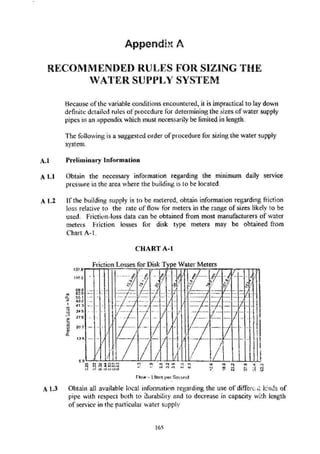












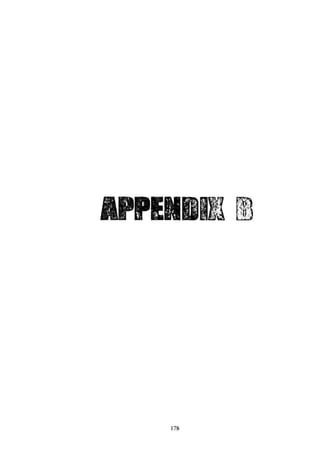



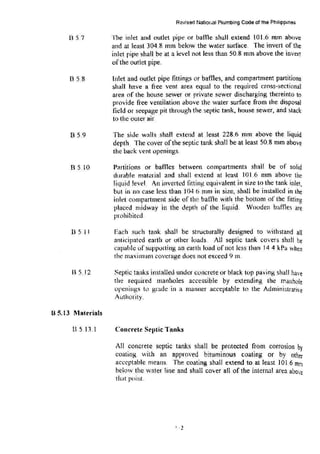










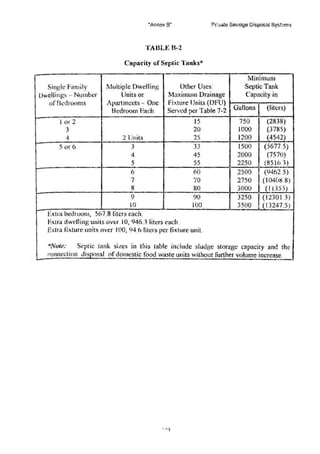





![Mm
38. 1
50 8
63.5
76 2
88.9
101.6
127
152 4
203.2
254
304.8
Revised National Ptum~inJ Code of th·3 Ph;Hppines
T1'lJlE U-2
PVC Cold Water
Building Supply and Yard P5ping
TIIRllST AT FITTINGS IN PASCALS AT
689 kPa OF WATER PIU:SSllRE
90° 45° 22-1/2"
lkmi~ BcnJ~ Bends
t~-U, R 1001.3
- ~ ll.~
- 2870.3 1557 s 801
4160.8 2269.5 Jl 57
--
6207.8 3359.8 1713.3
7~21 4280.9 2202.8
...........,
10212 8 5540.3 2815.8
15575 8455 4338.8
220"7.5 12059.5 6!63 3
3693 5 20025 l0l90.5
-
56960....-...-- 30705 15753
80545 43610 22250
Dead Ends
and Tees
~
- 1J12Ji
2Q24 8
3937
..
4383.3 .
~.]
noq
1l.Q12() 5 .
15707 5 3
, ...
A
26077
----...r.
40UZ.S n
I 56960
~
For a pn'ssure:· <~l JU33.5 f..J'a on a 101.6 mm tee, table U-2 (a) indicates
7209 N for 6?39 !cPa. lher~jim.~. lola{ thnol fur 1033.5 kl'a will equal /-112 times
720iJ Nfor a Jot,!i thrust (l,l 10810 /1.1. To determine the bearing area ofthrust blocks,
refer tv icJbit! {t-3 for the sc!fe bearing load ofthe soil and divide the lolulthrust by this
safe hearing load
199](https://image.slidesharecdn.com/188541488-revised-national-plumbing-code-of-the-philippines-220526020013-b02da330/85/188541488-Revised-National-Plumbing-Code-of-the-Philippines-pdf-206-320.jpg)


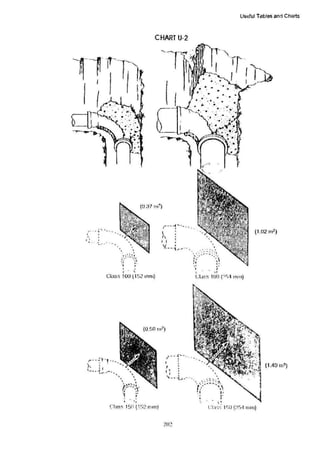

![Length
(mm) 4.,C
6096 7 l
l2l92 14.2
18288 21.2
24384 28 8
.10480 35.4
TARLE Ll-5
PVC-J)WV 'fYI·~~ I
TIU:RMAL EXI,ANSION TAilLE:
Chcut Shows Length Change in Millimeters
vs. Degrees Temperature Change
Q":fmrTJ
Coefficient of Linear Expansion: nun ()C
IO''C I6°C 2l°C 27''C
88 106 12.4 14.2
J7.7 212 24.7 28.3
26.5 31.8 17.1 42.4
J 5.4 42 4 tl'J 5 5(> 6
44 2 SJ 0 (I! 9 70.7
!lighest temperature expected
Lowc:;t temperature expcctcd
IOO"F (38°C)
_?J>''F .(Ht'C>
50''F (I one)
UsefLtl Tables and Charts
32°C 38°C
15.2 17 7
31 4 35.4
47.7 51.0
6] 7 70.7
79 6 88 4
1.('1/){lh ofnm 18288 mm.fmm d1an. read 26.5 mm lineor expan"iionlhat must be
1Jtm•id<:(J.for.
I](https://image.slidesharecdn.com/188541488-revised-national-plumbing-code-of-the-philippines-220526020013-b02da330/85/188541488-Revised-National-Plumbing-Code-of-the-Philippines-pdf-211-320.jpg)



![33
32
31
30
29
:L3
'l1
26
2.S
l4
2.1
22
21
20
r"'.
.g 19
18
] 17
16
e IS
§
t•
13
12
1l
..
10
9
8
7
6
5
4
3
2
1
0 0
v
/v
v
v
v
v
·-
COLD WATER SYST EMS
Conversion of Fixture Units to GPM
CHART U-3
/
/
j
/
/
v
,I
,·
/
,I
II'
~
v
v
v
v
v
v
-
-
Useful Tables and Charts
I
/
/
/
/
/
/
/
·
-
:- ~-
: !--t
I_
.Jjj
I -W
_j_j
~..J_j
~-+~~
I
I
-
-
1-
- -·
1 l 3 4 ~ 6 7 8 910 111113141!11617 18 19 20~ 1 21232425262'7232;)~·)
FIXT11Rt-: 1 ' ~ 11 S (Thnusamls}
DESIGN LOAD VERSUS FIXTURE UNifS, MIXI:O SYSTEM](https://image.slidesharecdn.com/188541488-revised-national-plumbing-code-of-the-philippines-220526020013-b02da330/85/188541488-Revised-National-Plumbing-Code-of-the-Philippines-pdf-215-320.jpg)
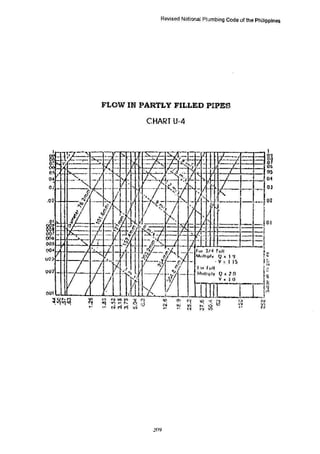
![NO.
I.
--
2.
_L
-~..:..-.-
5
6.
=~7~
8.
9
...
lO.
II.
_fl,_
U.
_GL_
l <;.
_!_y...;._
17.
-
J8.
_.!9~
20.
__f]_
_1.?~-
_f_J __
24.
.
25.
.,6
.....~..,!..__
21...
.,8
--"<...!.~
_2~-
30.
....:~.L-
__,l2
JJ
H
··"------'-
.15.
.16.
-·-
37.
--
38
-
39.
-----
4()
Useful Tables and Charts
TAIJl.E U-9
Conversion Table
MULTIPLY UY TO OBTAIN
Acres . . .. . .-· 43 560. S.y_uare feet
_Ag~-fcet. . . . . . - . ._._.___11..560. . . _(_l!Qic ~ct
_,~cre.:fecL_._._.~--"---'--'-'----
._._
.._
. . 32~.&51 .. .. U S. Gallq_ns
Atmosuh~re~, . . .... 76.0 .__
.._._._!:_m~.f mcrcurv
Atmo~heres. . . . . . . . 20.92 . .. Inches ofmercury
Atn!_o_sphcres ~--
....:.....-..· ......... 33._2_Q_-....:.._·
._._l·~et_.Qf_~ater _
A~hcl:fi~.........~~~~~ 11.1!.1 ..... Pound:J~uare inch
Dtu(mi_l!~~1~....:-:....:....:...:.:....:....:_·_
..__
. _
..__ 12.96. .. Foot-Pounds/second
--
Bt!t/minut~..:....:- . . . . . . . 0.02356. ... Hors~owcr
Centimeters . . . . . . ... 0.3937 ... Inches
( entimet~rs of mercury_. . .. 0.01316 ... Atmospheres
.Centin)ct~rs of mercury . . . - 0 4461 .. Feet ofwater
S~cnti_r_!_l~cr~_.Qf mercu_!)' . . . . 27.85.-. . . Pounds/s~~are feet
..crotimtteis of me.ruuy ' • I I I JU911. l?uundsL:squart..inch
Cuhie feet . . . . 1728. Cubie inches
J~tgli_c I~L_._. _
..._
_. 0 03704. C@jf_:&·uds
-~
. . . - .
--
C'~Q_ic feet .. . . . . 7.48052. l,LS, Q~JlniJ.!i... --------..
Cubic feet ....... . -. . . . 29.92. Q~arts tili.JuHl)
Cubic teet/minute ,_ 472.0. __
.._._ Cybic Ct.!!f~_econd '
.. ..
Cubic feet/minute. ... 0.1247 .. . . Gallonslsccofld I
Cubic feet/minute. 62.41 Pqunds of water/minu~.:J
Cubic fC'et/se<.:o~~ . . . . . . . 0.0646317 . MiJ_Iion ~!allons/day J
.Cubic _fectisecond . . . .. 448.831 Gallons/minute ·
Cubic yards . ... . . 27. Cubic feet
Cubic yards . . -. . . 202.0 . U.S. Gallons
.. . -..&"':":'
.f~~t~tcr . O..Q22.~tL..............._A1m~UL. !
t ' t l
'
• t.
' -.."'
Feeu~.fwat~r. . . . . . . 0.882~ . . . ln~!tes ofiTJcrcu_ry___ _)
£~et of water . 62.43' Pouodslsqtmtl'eet ~
'
. '
I . . .. • t • •
'
t .
.B:~t.Qf.~..at«........ .. .. ~
'
0.4J]S I I
'
Poynds/sqv~ inch _J
Feet/minute. 0.01667 .. Feet/second "
.. . ..
=-.·-~~
Feet/minute . -~
0.01 ny_._._._._Miles/hour •
... . .
'
Fect/s~cond . .. . . ____
0.6fi.L~~_Mi~?!hm.tr _J
FCCl/~Q!H.L 0 QlJ..l(i_.__.......__Mi~lminutc
'
- -----~
Gallons U.S .. 37~5_._._
.._()._tic_ £~n.tin_lctcr~ ~
._._......___..__..._....:....~...:.-·
·-·-·-·
·-·-·"'
'
Gallons U.S. . . 0.1337 . Cubic feet ~
Gallons ll S. .. . . . . 23 t Cubic inches
·"·~-'
~
-- --1
Gallon~ U_S .. 1_
.._
..__Q!:!~n~i_QJ!id.L ~
,
Gall9n.U:~~~r U.~-'-'-. 8,3453 Pounds ofwatt:r
,;
.. I!
Gallons/minute U.S ·----
. . . 0.002228 . Cubic feet/second
·aaffonstrn~nutc_____ ---· -----·---- --·----
H 020~. Cuhic lcet1hour](https://image.slidesharecdn.com/188541488-revised-national-plumbing-code-of-the-philippines-220526020013-b02da330/85/188541488-Revised-National-Plumbing-Code-of-the-Philippines-pdf-217-320.jpg)

![Useful Tnbles and Charts
TADLI': 11-10
METR1C SYSTEMS
(IN'IJ-JlNA 110NAL SYS11·:A-tOF UNf7:<; ···Sf)
NO. TO CONVERT iNTO MULTIPI.Y BY
~.~~~--~--~~-----------
_J-'-- t-AtO)Ql'.Q~~L~.:-;_ J,:!~~-.Ql_!!l9_LCUI)'_________
751.:..0~--------f
_2.__ Llliu.___-·----· _luuk.!L-·--·-- ----·---· ..U~------·
1 B.1J..I.Llmur _
____w~___________U.2231 __
4. Btu/minute _
__Kilowa_tts_.__ 0.01757 __
5. Btu/minute Watt:> 17.57
-~:.... C'ent~<l£_.______Fa_!m~fliJ~.it (C x 9/5) + 32° ·-
_7_.,._ 1-Circll..~ fcJ:ence Radi<uJL________ _ __6=""'·=2=83::;._____--t
_8_._ Subic -~~ntirn~!~li- Cybi.~ iu~h.~.L____ ---"'0-'-'.0'-"6,-=1._,_0=2---------~
9. Cubic feet Cubi' meters 0.02832
·--·-·- f---'-"---------·--------·--·----- ·---·-----1
l0 Cubic feet Liters 28.12
_lJ...__ J.JJbic rcc£/mim.Jt~___..C.Ul!ic cms!~nJi________172.Q.______
12. Cubic..i!l.fllcs .. __ ··-·---··------!:~J.Q.'.~-~Hl~ -·-·······-··--·····___LQ.J9 ------
IJ. C'ubic inches Litt~rs 0.01639
~--·-·---------------·----··----·--·····-··---·-·--··---·-··· ·--·---·----
14. Cuhic mctc:rs Gallons (U.S. liq~&iQ_)_____--1§4.2_____-...~~
15. feet Centimeters 30.48
16 Fect 1k~r.L ______U3JH=8'-----··-
l7. Feet .. ____hfilliu~!~ll..-------··---~04.8 -·---·--.,'l
_J8. Feet of water Kgs/squarc em 0.03048 ~
19. .Foot-Pounds Joules ____ 1.122._______~
20. Foot-pounds/minute Kilowatts 2.260 x w·~ ~
T"'* ~
2!. t:Qot--p_oundslsccond ~Uowaus I. J5§~ ;;
_12_._ ..f.iallwu (U.S.) Li~.s ----~5 -~
..21. · Jlru:.s.cpuwcr,. Watts 745 7 •:
24. llqr.s~m-.hlli!(S Joules 2.~8_4_x_!Q6
..........-'-'--'""-"----~
25. Horsepower-hours Kilowatts 0.7457
..7..~- J~ules _ Bt~ _ 9.480 x 10-4
27. Jl"'ulcs Fcol-J29Uf!ds . 0.7376
....4-L Joule~ Watt-hours 7..77'6 x i"Q-'f" J
--~9 J5:~J.<)Jil:~ms_______l_,_~~~~s -==--=-----22os-· l
30. Kilograms Tons tshort) ----~-1j()2x 10"1 l
_}_L_ J~!Jomcters Mi!£s
__._______ 0.6214 ~
3~-'---- K~illJ!l_eJ~rslhour Miles/hour QJ~~l4__ ~
__J3.__ ~!!_<!_watts llor~~owcr l.341 ~
_]4_ Kih~}Y~.U--hours ll!u 3,41'3___
35. Kilowatt-hours Foot-e)utnls 2.655 x !()6 -
36_ Kilawatt:-_hours Jouj§_________·_. i6*;j06~--,,~
_31~-~-Utlli......-. Cuhkf~L___ ·--··-·---···- _JL03S3L_. J
_,HL.. .JjJ~f...~J~t~r:~. ·-·----·--·--· ..<!?.llq_n_s Ht5 liqili5:il. ____.__JL264L..
-=-1~L...Mett,'l~-----· ·-- -·-----·----····-J::.£ct ... -·- ---·. -·-·- ... _ ----··· 1.2R1 -·-----..~
40 1ktcrs Inches J9.H](https://image.slidesharecdn.com/188541488-revised-national-plumbing-code-of-the-philippines-220526020013-b02da330/85/188541488-Revised-National-Plumbing-Code-of-the-Philippines-pdf-219-320.jpg)
![JA HiI: f1-1() (( 'owinued)
Revised N3t!onal Plumbing Code of the Phi!:pp;nes
TAULE U-lO
METRIC SYSTEMS
')
(IN11·.RNA IJONA/, SY. 1/<:Af (>F f!Nfl:. ''!)
NO. TO CONVt<:Rr INTO MlJLTIPLV BY
-
41 Meters Yards J.(J94
-- --------·--~- -- .. ··-- '·-·- ···· --·--·-· - ··- .....-·------·-....···- ------· --- ------- -
42.
·-·--"'--
-~-:ht~I~!:~ec~Jnd _____···---. E~~J/s~~!:?JlQ·-------- - - - _3.281 ·-
-~~ -~ctcrs6£.~.i-~ng____ ~1,lesf.h£__ _______ 2.237 ..._
...1.4;_ _
MjJcs_btatut(.'l___..____ .K.JJ.omCtl:rs _ ..,.____...______.J! 1_.608 ..
45. Miles/hour Meters/minutes 26 82
46 Millimeters Inches 0.03937
~ --- ...
=
•
!I:f{.!'!'"esf!lui~L____ Lit_crL_
___
_____
___ ____ _ I!-Q.01957 ·-·- - ---
..i~- Pin!ti!!.
CJ!!i9L_______,____
_
""r~-~~~~~ ce~gj_~~~J<-:~~----·------ -~~.I?_1_ .
-4b~- -~~~~~~~?.._______.._____ _ _ f~(~:~::Jt-~~-----------·-····-t£~~~~6
--·-----;
-~
_j_L_ .Ql!i~!.t§l!i_(tt_~~!L_ ---------- ~_!jt~rs__________________ 0.9_1_~_
1 _ ____
-F·-··~_ad_i.~-~.t~-------------------- 1?-~~~-~--:--:----- _
__ ____ _ fs_~}Q_____.._
_
_____
.-~.:.... ..~.q~~~~<;J!~~~---------- 5_l~!.~rc nul!J_rnctcr~.---- _... -- 1~1~~L__ ______
.. ~
....54;_ -~lll~31'l' m~_l_;:·s ----- ---- --- s~~~-~? ~nche~- ,__J..~550___ __J
55. Square mtllunetcrs Square mches t550....::..IO,.-- ~
J.6_ ~Y~~.t!L_____________ Btu/hom · .1 4129
. -- - - .. ..___
_·- - ----
----·-·- ----·----·--··- ----·- ·
S7 Watt~ Bt ' · · t • • o050~8
. · -'- ---- -- · -·····-----· ----·----- _ __JJ~I_llll !ll C . . . >
•
- ···-- ·- ... .----- ---------- .. r-·--·-----·--
--- -- -
_
_58.__ .W.JlU~-·------__ ·-._____ FQoi-VWJJl~.h/sc~Q_Il.<i..________ .Q.7J 21~-------]
59. W:llts llorsepowl'r · 13,11 x 10 1
•
.--.:.t .~.OI......_..~~.-:..~
.'. 11](https://image.slidesharecdn.com/188541488-revised-national-plumbing-code-of-the-philippines-220526020013-b02da330/85/188541488-Revised-National-Plumbing-Code-of-the-Philippines-pdf-220-320.jpg)



